
No-weld - Gates Custom Made Without Welding
No-weld is a revolutionary new patented system that brings the Fabrication of Residential and Commercial Swing or Sliding Driveway or Pedestrian gates and Aluminium Fencing into the 21st Century. The system is similar to that used for aluminium windows and screen doors but is for gates and fencing.
How No-weld Works
No-weld uses lengths of custom extruded aluminium combined with corner brackets and materials such as aluminium slats to make gates that screw together without welding. All screws and brackets are hidden inside the frame with clip on back covers.
Many different designs of gates are possible with No-weld as follows:
Slats Inset into the frame
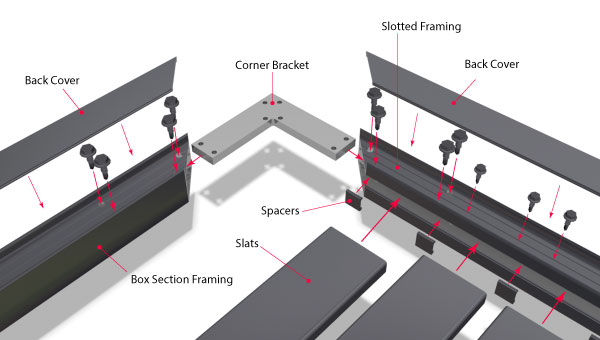
Corner brackets are used to hold the frame together. Slats are inserted directly into a slot in the No-weld frame. Spacers clip into the slot between the slats to set the gap and fill the gap in with the same material and finish as the frame and back covers also made from the same material and finish clip on the back so screws aren't seen resulting in an a beautiful clean finish with no screws or welds visible.

The finished gate has slats inserted directly into the frame with no screws or welds visible. No-weld Frame members without slats inserted have no slots so are a box section framing.
All Box Section Framed No-weld Gates
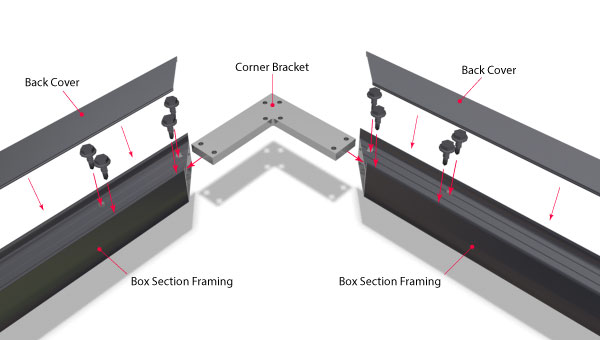
Other designs of gate can have a frame made entirely from box section No-weld framing with corner brackets fitted into the ends of the framing and cladding fitted in different ways depending on the gate as shown in below:
Slats or Battens Face Mounted on the frame

Aluminium or timber slats or battens may be fitted to the front of the box section No-weld frame screwed from the back through holes in the frame so screws aren't seen and holes are hidden with clip on covers.
Vertical Tubes Inset into the frame
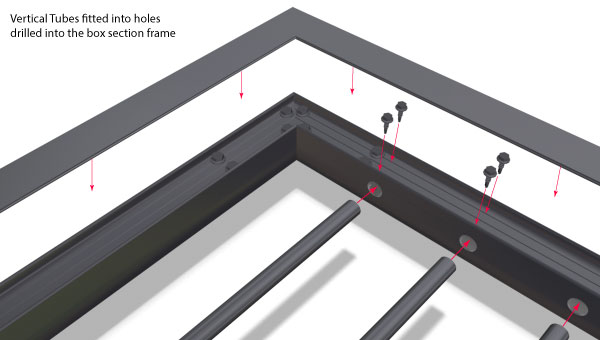
Gates with vertical tubing can have holes drilled into the box section No-weld framing with tubing screwed to the frame through the open back with back covers clipped on so screws aren't seen.
Colorbond sheeting Inset into channels on the frame
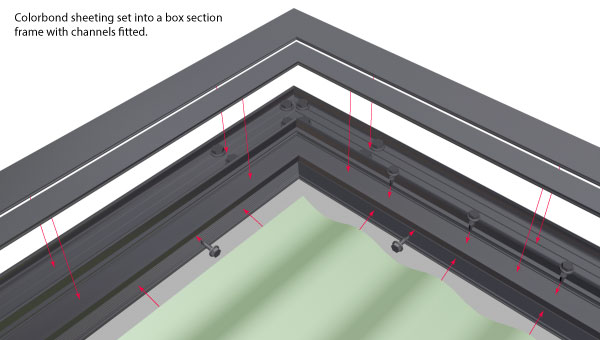
Gates with Colorbond sheeting set in the middle of a frame can easily be put together with channels screwed to the box section No-weld framing and cut with the framing for a very clean finish. Colorbond sheeting of many different profiles can fit hard up into the channels making it very neat and tidy.
Laser cut sheeting set inside the frame
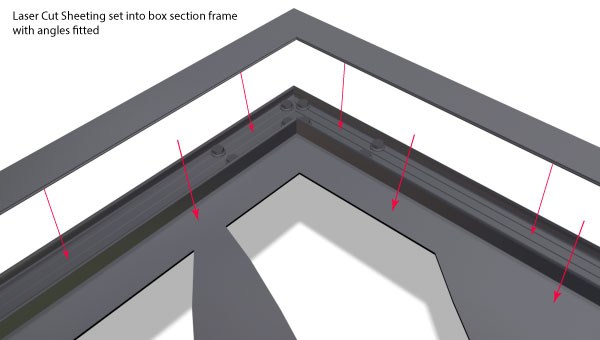
Laser cut sheeting can be set into a Box Section No-weld Frame using small angles riveted to the inside of the frame cut with the frame and laser cut sheets then glued or riveted to the angles.
Timber Palings or other Materials Face Mounted to the frame.
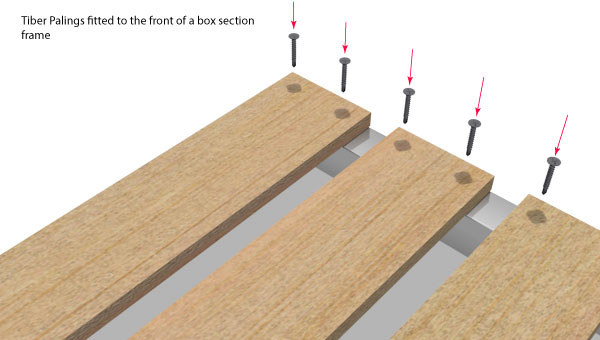
Timber palings, slats, Colorbond Sheeting or Laser Cut Sheeting can simply be screwed, riveted or glued to the front wall of a box section No-weld frame because it has the thickness to allow for this.
What can be Made with No-weld?
Swing and sliding driveway gates including telescopic sliding gates and pedestrian gates can be made in many different styles with matching infill panels and aluminium slat fencing ... READ MORE
What Finishes can No-weld Have?
No-weld Gates, infill panels and fencing may be mill finish (raw aluminium that has no coating), anodised with a range of metallic looks, powder coated or can have a baked on durable finish that looks like real wood ... READ MORE
What are the Advantages of No-weld?
- Clean, elegant and architectural look not possible with welded gates nor any other non-welded systems. Achieved with the patented frame design that screws together with screws being concealed by clip on back covers.
- Fast Turn Around is possible if pre-finished No-weld framing and cladding is kept in stock.
- Flat packed for more economic transport and less likely to be damaged in transit so gate and fence kits can be freighted Australia wide opening up a much larger market for fabricators and servicing more isolated locations.
- Driveways that slope across aren't a problem with No-weld unlike other non-welded systems that will only work on flat ground. READ MORE
- Finishes not practical or desirable with welded gates such as mill finish (raw aluminium), anodising or a finish that looks like real wood. READ MORE
- Many different designs are possible with No-weld unlike other non-welded systems. READ MORE
- One person can make, assemble and install larger and heavier gates themselves onsite if they need to, ideal for DIY and Professional one man band installers READ MORE
- No bowing or warping due to the heat from welding so much easier to get accurate, flat and square.
- Easy fixing of mistakes or damage after a No-weld gate has been made it can easily be pulled apart and altered or repaired rather than having to remake the entire gate from scratch. This is possible because the screw covers can be removed READ MORE
- Efficient use of material by using cladding materials to improve the strength of the gate where ever possible, keeping costs down and is good for the environment.
- Telescopic No-weld sliding gates can fit into tighter spaces, look nicer than other systems with the drive mechanism and guide system cleverly build into the frame, will work on sloping driveways, can have gates with slats or battens fitted to the front of the frame and can have three or more panels. READ MORE
- The gap between slats can be adjusted allowing them to fit neatly into the frame with matching aluminium spacers to fill in the gaps between slats for a very clean finish or can have no gaps.
- Slats are much quicker to fit to No-weld gate frames even if the gate is on a sloping driveway or slats have no gap.
- A No-weld gate fabricator can be trained in much less time as opposed to taking years to learn how to weld gates neatly and quickly.
- Electric cable for electric locks is much easier to fit inside a No-weld gate frame because it simply goes in the frame before the screw cover is clipped on, no more trying to feed the wire through the frame after it's made.
- Electric strike locks can be recessed into a No-weld post with no extra screws required in the frame as is necessary with standard framing.
- No-weld can have components added if necessary such as scrolls or other details glued onto a No-weld double top or middle rail. These pre-glued assemblies can still be flat packed and screwed together with the rest of a No-weld frame allowing almost any design of gate to be made with matching fencing.
- No-weld Infill Panels or screens can be fitted into a closed in hole in a wall with no screws visible, no other system can do this. READ MORE
How strong is a No-weld Gate?
No-weld gate frames are mostly made from box section aluminium extrusion that has similar strength to a 40mm square box section aluminium that has been used on welded gates since day one so is a tried and proven material for all styles of gate frames. The strength of a gate is determined by the 'stiffness of a gate' that is a gates resistance to twisting or bending and 'bracing of a gate' that is its resistance to a swing gate dropping from its hinged end or a sliding gate sagging between its wheels.
The corner brackets of No-weld gates are cut from 10mm flat aluminium and are screwed inside the middle of the No-weld frame with the screws spread by 120mm from the corner, which provides more 'bracing' than a welded corner and an equal amount of 'stiffening'.
No-weld gates with slats set into a No-weld frame have the slats inserted into a slot in the side of the framing directly, although the slotted framing is technically a 'channel' that offers poor 'stiffness' if used as a gate frame on its own compared to a box section frame, the slats are in fact box sections and because they span between slotted frame members they provide the necessary 'stiffness' of the gate and each slat also provides more 'bracing' than is needed to hold its own weight. Box section framing is still used where slats are not inserted into the frame resulting in a gate that is as strong as any other if not stronger.
To further add to the 'stiffness' and 'bracing' of a gate in general a technique that has also been commonly used from day one for welded gates is to add middle rails and middle stiles made from the same box section as the rest of the frame. These add significantly more 'stiffness' and 'bracing' to a gate than using a larger material such as 50mm square box section instead of 40mm. This works with No-weld too, in fact we've found that gates with horizontal slats set into the frame with vertical supports screwed to the back of the slats are the same strength as a gate with a middle stile.
We have also found that when face mounting slats or battens to a gate frame by screwing them from behind near each edge of the slat or batten and in the middle of the frame member adds significantly more 'stiffening' to a gate than if they are welded to one edge of the frame. This reduces the need for a middle rail or horizontal back support for No-weld gates with vertical slats or battens.
Extensive Research
We have done extensive research on what makes gates strong, which has been the bases of the development of No-weld. Our findings are as follows:
Extruded aluminium 'C' channels or 'T' sections provide reasonable bracing strength but can twist easily so aren't very good for a gate frame. A square or rectangular box section makes the best gate frames because they resist being twisted although offer the same bracing as a 'C' channel or 'T' section. That is if you hold a length of 40mm box section at each end it will sag in the middle under its own weight, a length of 40mm x 40mm channel will sage by the same amount, yet a gate made from 40mm box section will be quite stiff where as a gate made from channel will twist very easily and the frame will bend more easily too.
The most efficient way of improving stiffness and bracing of a gate is by using whatever bracing and stiffness the cladding has to offer. For example with a gate that has aluminium slats fitted, these are a box section normally 65mm x 16mm, if these slats are attached to the frame firmly and span between frame members of a gate frame each slat provides significant stiffness and more bracing to the frame than the weight of that slat will cause the frame to drop or sag, resulting in a gate that is stiff and well braced.
The secret to getting this to work is in the way the slats are attached, if the middle of the slat is attached to the edge of a frame then the slat can pivot relative to the frame in more than one direction so provides no bracing or stiffening. If the slat is attached from both edges of the slat to the both edges of the frame then the slat cannot pivot relative to the frame so provides maximum bracing and stiffening.
How does this apply to the real world? well with welded gates a slat is generally butted up to a frame and is tack welded from the back, with a tack near each edge of the slat, which provides bracing but not stiffing unless the slat was welded on the front too, although this doesn't look nice so generally isn't done so the stiffening of the gate comes from the box section frame only, which is ok with smaller gates but larger gates can become too springy. Now a No-weld gate has the slats inserted into a slot in the frame and is screwed to the frame from the middle of the frame member and close to the edge of each slat, which provides both bracing and stiffening. This means a larger gate with vertical slats set in the frame can be up to 2m high and 6m wide with no back supports where as a welded gate would need a middle rail or horizontal back support to stiffen it up enough.
Gates with horizontal slats do need middle stiles or back supports if the gate is more than 3m wide because the slats are only 16mm wide and will bend easily if they span more than 1.5m so adding a middle stile means they never span more than this so provide the same amount of stiffening as vertical slats. Also because gates with horizontal slats have less slats providing bracing and more weight to cause the gate to sag or drop one middle stile or back support doubles the bracing effect of each slat and halves the weight effect so improves bracing and stiffening by four times.
Gates with cladding that doesn't add significantly to the stiffening of the gate such as timber palings or thin flat sheeting fitted to the front of the gate can be stiffened by adding more middle rails and/or stiles. If a frame without a middle stile is doubled in width it becomes four times less stiff but with one middle stile it is the same stiffness as a gate half its width without the stile. The timber palings or flat sheeting can provide bracing if attached correctly, although a middle rail and/or stiles add to this too.